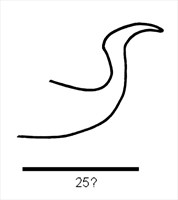Click on images to enlarge

Fig. 1. Oligonychus calicicola adult female - detail of pattern of dorsal striae between setae f1 and f2; detail of empodia I and IV (redrawn from Knihinicki & Flechtmann 2008)

Fig. 2. Oligonychus calicicola adult male - detail of aedeagus (redrawn from Knihinicki & Flechtmann (2008), including scale which seems inaccurate).
Material examined
specimens not examined
Taxonomy
Subfamily Tetranychinae
Tribe Tetranychini
Distribution
*Australia: Northern Territory
It is unknown if this is a native species - see Knihinicki & Flechtmann (1999) for more details.
Diagnosis
Female
- empodia I-IV = curved claw, longer than proximoventral hairs (Fig. 1)
- tarsus I with the socket of four tactile setae and one solenidion proximal to the socket of the proximal duplex seta
- tarsus II with the sockets of three tactile setae and one solenidion proximal to, and two tactile setae overlapping with, the socket of the proximal duplex seta
- pregenital striae mostly longitudinal (often with some irregular/mixed striae present)
- peritreme ending in slightly expanded bulb
- dorsal striae mostly transverse, except with longitudinal striae between setae f1-f1 (Fig. 1)
- chaetotaxy for legs I-IV:
- femora 8/10, 6, 4, 4
- genua 5, 5, 4, 4
- tibiae 10(1+0), 7, 5/6, 8
Male
- empodium I = bifid claw, ventral claw slightly longer than dorsal claw
- empodia II-IV with dorsal claw strongly curved, slightly longer than, or subequal in length with, the proximoventral hairs
- tarsus I with the sockets of four tactile and three solenidia proximal to the socket of the proximal duplex seta
- peritreme ending in simple, slightly expanded bulb
- chaetotaxy for legs I-IV:
- femora 9, 6, 4, 4
- genua 5, 5, 4, 4
- tibiae 12(4+0), 7, 6, 7
- aedeagus dorsally directed, with long neck; axis of knob more or less parallel to that of shaft; posterior projection strongly tapering to point; dorsal margin of knob convex, downcurved distally; anterior projection non-existent; dorsal margin of shaft forming slightly acute angle (Fig. 2)
- pale green with yellow tinge, darker green food spots dorsally, and legs yellow.
Hosts
*Phoenix dactylifera (Arecaceae)
Similar Taxa
Biology
These mites are so far known only from date palm, Phoenix dactylifera (Arecaceae), and tend to be located at the calyx of the date fruit, but scarring has been observed all over the fruit after harvest and that crop was rendered unmarketable. The species produces thick webbing within the bunches of fruit.
References
*Knihinicki, D. K. & Flechtmann, C.H.W. (1999) A new species of spider mite, Oligonychus calicicola (Acari: Tetranychidae), damaging date fruit, Phoenix dactylifera L. (Arecaceae), in Australia. Australian Journal of Entomology 38: 176-178
Notes
Knihinicki & Flechtmann (1999) suggested that date palm may not be the true host for this species, but that the locally dominant grass, the introduced buffel grass Cenchrus cillaris L. (Poaceae), may in fact be the host.
Copyright © 2018. All rights reserved.